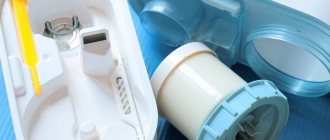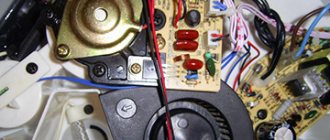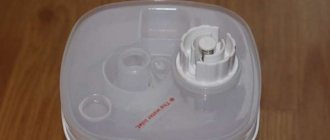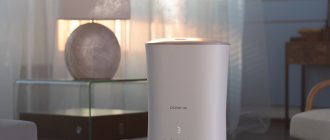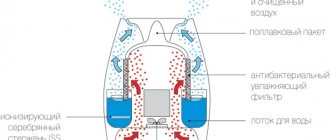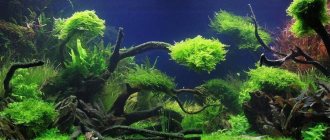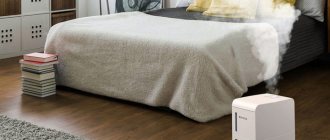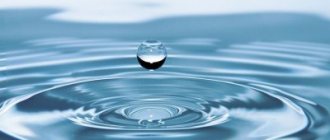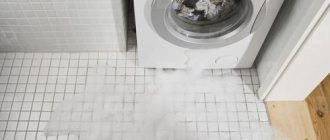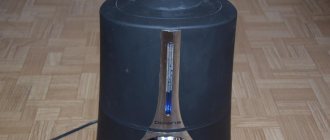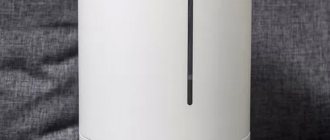Why is air humidity important?
Humidity is one of the key characteristics of indoor air quality. According to sanitary standards, the acceptable level of relative humidity in a room in the warm season is 30-60%, in the cold season - 30-45%.
For children, doctors recommend raising this value to 50-60%, since a young developing organism is more sensitive to air parameters. We recommend that you familiarize yourself with the pros and cons of using a humidifier for your child.
To measure humidity, a special device is used - a hygrometer. However, purchasing it for home use is not entirely advisable. A much more profitable purchase would be a wireless weather station, which, in addition to air temperature and atmospheric pressure, also shows the level of relative humidity. Advanced models display information not only about weather conditions outside the home, but also analyze the microclimate in the room itself
The level of air humidity quite clearly affects the state of the body:
- Excessively dry air becomes a companion to long-term respiratory diseases - the depleted mucous surface cannot resist viral or bacterial infection. Therefore, the recovery process is delayed, and undesirable symptoms in the form of a runny nose and cough manifest themselves even more clearly.
- Low humidity makes breathing difficult . Due to lack of oxygen, dizziness and other ailments may occur. It is extremely difficult to concentrate on work in such an atmosphere.
- Skin and hair are the first to suffer from dry air, losing their own moisture . The surface of the eyes also becomes dry, causing the person to experience discomfort.
Additionally, dry air can cause damage to wooden furniture, various finishing materials, musical instruments, and negatively affect indoor plants. During intensive operation of heating devices, the humidity level drops to at least 20%. To avoid these problems, you need to buy a suitable model of humidifier and fill it with high-quality water.
Air humidity and its meaning
One of the most important air parameters that ensures a comfortable stay in a room is relative humidity.
Relative humidity is the ratio of the actual moisture content in cubic meters. air to the maximum possible value at a given temperature.
According to the standard, the value of this indicator should be 30-45% in winter, and in the summer it should be within 30-60%.
At the same time, doctors recommend relative humidity levels of about 40...60% for any time of year, and for children from 50 to 60%. The famous pediatrician Komarovsky strongly advises that when a child has a cold, increase the humidity value to 70%.
It is difficult to ensure such humidity levels, especially with stable operation of heating equipment in winter. Therefore, special devices for air humidification are used for this. And when using them, the problem arises of what kind of water to pour into the humidifier for its effective operation.
The quality of such water is extremely important for people. The vapor from this water directly enters the lungs. Water indicators also directly affect the efficiency, reliability, and durability of the humidifier itself.
Attention. Improper water preparation is indicated by:
- changed color of water;
- white coating on various surfaces of the room;
- lime deposits on the device heaters;
- green deposits in the tank;
- musty smell.
are quite unpretentious to the quality of the water they fill . Any clean water will ensure the operation of a device of this type. However, given that the water for the humidifier in the form of steam will be inhaled by the owners of the equipment, it is worth using special filters to remove chlorine and other impurities. It is useful to reduce the water hardness level to protect the heating element from scale.
Cold-type humidifiers are based on the use of special cartridges that saturate the air blown through them with moisture. Such cartridges are quite sensitive to the quality of water, which is best distilled. Or at least high-quality filtration.
Spray models that spray fine droplets are the least sensitive to water quality Tap water is quite suitable for the device itself. But it is advisable to first pass it through a regular filter to remove chlorine.
The most important solution to the problem of what water to use for a humidifier is for ultrasonic models . Such humidifiers create water vapor when water is exposed to ultrasound. However, in this case, the mineral impurities contained in the water undergo fine transformation. They are the ones who create a white coating on things and surfaces in the room. You should also prevent them from getting into your lungs. Therefore, ultrasonic humidifiers necessarily require distilled water, free of mineral impurities.
Water for ultrasonic models
Ultrasonic humidifiers are the most finicky among all types, but they are also the most advanced and productive. The operating principle of such devices boils down to the conversion of electromagnetic frequencies into mechanical vibrations. Oscillations of the switched-on device form waves of different pressures. As a result, even at the most ordinary temperature, the liquid begins to boil, and finely dispersed particles are released into the air. With the help of the air flow generated through the action of a fan, particles are carried throughout the room, creating steam.
The process, as you can see, is quite complex, and therefore the requirements for the water involved in it are very high.
Water for such an air humidifier must be demineralized and distilled. Otherwise, you will have to change cartridges frequently, and their price is very high.
If you are not ready to provide the device with water of the required quality, then it is better to refuse to purchase such a device in favor of another, more affordable to maintain.
Ways to check air humidity levels
The best way to check is to use a hygrometer or weather station that reads information indoors.
However, if such equipment is not available, you can approximately calculate the humidity level using an ordinary glass of water .
The method of checking the air humidity level using a glass will not give specific percentages. However, in this way you can clearly find out whether the microclimate in the room is sufficiently humid
A glass glass must be filled with cold water and placed in the refrigerator so that the temperature of the liquid drops to approximately 3-5 degrees Celsius. After this, the container is installed in the room at the maximum possible distance from the heating radiators.
If the glass becomes covered with condensation that dries within five minutes, the humidity in the room is considered low. Average humidity is indicated by the persistence of condensation on the walls of the glass even after five minutes. If the glass is covered with small streams and drops, the level of humidity in the room is increased, there is no need to buy a humidifier.
Types of humidifiers and their functioning
Manufacturers offer extremely ergonomic and functional models that work on slightly different principles. What exactly needs to be poured into the humidifier fundamentally depends on the type of equipment. There are several types of such devices currently available on the market.
Type #1 - steam humidifiers
Steam humidifiers evaporate water through natural heating processes. The liquid is brought to a boil and then turns into steam.
These are the most effective models, however, they are not without certain disadvantages, among which are:
- high energy consumption;
- the need to control the level of moisture.
However, some modifications can even be used as an inhaler if the kit includes a special nozzle.
The working principle of a steam humidifier is shown in the diagram above. The design may include a separate compartment for oils. This allows you to make the air not only more humid, but also fragrant. Additionally, some essential oils, such as tea tree, have antibacterial properties that can neutralize airborne pathogens
A significant advantage of such a humidifier is the device’s low demands on water quality, since any clean liquid is suitable for it: artesian, spring, demineralized or distilled. However, it is worth remembering that the generated steam will be inhaled by people, so you should not fill the humidifier with plain water from the public water supply.
Type #2 - cold type humidifiers
Traditional cold-type humidifiers require special cartridges that saturate the blown air with the necessary moisture. Such models are filled with liquid, which the built-in fan drives through the cleaning unit.
Cartridges are extremely susceptible to clogging, so distilled water, free of any impurities, must be used for them.
The diagram shows a cold-type humidifier device. In addition to the main components, the device can be equipped with an air ionizer, an additional antibacterial filter or even an ultraviolet lamp, which also fights microorganisms
However, the cartridge still requires regular replacement: on average, it is updated at least once a quarter. If you do not use distillate, the cartridge will partially remove impurities of heavy metal salts and make the water softer, but will quickly become unusable.
Type #3 - ultrasonic humidifiers
Ultrasonic models produce moisture due to mechanical vibrations on a special membrane. Water entering this unit is split into fine particles, which are carried away by the air flow generated by the fan. The process is carried out without heating, however, along with water, any impurities contained in the liquid are split into fractions.
Therefore, although the ultrasonic humidifier is extremely convenient and productive, the device remains the most sensitive to water quality. Only a distillate that does not contain minerals or unwanted metals is suitable for it.
We discussed in more detail the features of ultrasonic humidifiers, their pros and cons in this material.
The figure shows the structure of an ultrasonic humidifier. In addition to the membrane, the device may have additional cartridges and coarse water filters, which improve the quality of the generated steam
The most primitive and least demanding of water are spray humidifiers, which simply spray tiny drops of water into the air. Any purified water is suitable for them, but do not forget about its characteristics, since microdroplets will get into the lungs.
Another type of humidifier is equipment with an air purification function. We talked more about purifying humidifiers in our next article.
Water for an air humidifier - its preparation and features
The question of where to pour water into the humidifier is decided by a detailed study of the passport of a particular device. However, there are a number of general rules that do not depend on the model and its type:
- the remaining water from the device’s reservoir is completely drained;
- the tank is thoroughly washed;
- limescale is removed with a weak concentration of vinegar solution;
- The tank is finally rinsed.
For spray-type , bottled or filtered tap water is suitable. Already, most pitcher filters eliminate chlorine and significantly reduce the amount of mineral impurities. Flow-through filter systems allow for deeper cleaning. And the best water quality is provided by filter models with reverse osmosis.
The best solution for cold-type models , steam generators, and ultrasonic devices is distilled demineralized water. It can be bought in pharmacies. In order to save money, it is possible to use technical distilled water for batteries.
Existing tips on using boiled water are not suitable for ultrasonic humidifiers, since this method, even with subsequent filtration, can only remove about a third of mineral salts.
Care instructions
A device that is an air humidifier with aromatization is preferable to conventional models. But it is worth remembering that it is advisable to wash the equipment after each use, to avoid the formation of harmful bacteria in it. It is also important that aromatic oils should be chosen with special attention. Essential oils can have both positive and negative effects.
We must not forget about individual odor intolerance, possible allergic reactions and more. The use of a device with aromatization must be careful; negative reactions in the form of dizziness, irritability, even nausea are possible; there are also more unpleasant manifestations. The fault lies largely not with the device, but with inept use. Oils should be added in moderation; advice should be given as to which ones can be added and which ones cannot.
Many odors, despite their pleasantness, can cause rejection by the body if constantly inhaled. Any flavoring can cause harm if used excessively. Moderation is one of the key factors in use.
No less important is the choice of which aromatic oils to use for the home. Preference in recommendations for use is given to chamomile, lemon, anise, lavender, cloves, fir, peppermint, sage and others. But this does not mean that you can add these oils as much as you like without learning your personal tolerance to their smell. No less important will be the opinion of relatives and people living together. Supplements can cause delight for one person and complete rejection for another person.
Therefore, aromatherapy should be the key to solidarity. After all, with the abundance of options, there is always a solution. It is advisable to add an essential oil to your humidifier that everyone will enjoy. It is recommended to mix several types of oils to obtain a richer aroma. Considering that hundreds of thousands of scent combinations can be added and essential oils of different properties can be used, it is easy to find the perfect compromise. The main thing is to observe moderation and be careful.
What kind of water to pour into an ultrasonic humidifier
Inside such a device there is a membrane that vibrates at a high frequency. The liquid inside also begins to vibrate, as a result of which it breaks into small particles and turns into steam.
The fan blows it into the air, causing the humidity in the room to increase. Ultrasound does not have a negative effect on the animal or human body; such models quickly and effectively increase the humidity in the room.
Humidifier device
Expert opinionNikonorov Vladimir AlekseevichOur expert. Specialist in the field of air conditioning and ventilation with 10 years of experience. It is better to pour distillate into such devices, otherwise mineral particles are actively released during the process of converting liquid into vapor into the air. They accumulate on the parts of the device, reducing its performance, and also turn into a white coating that gradually settles on the furniture and causes harm to the body. It is imperative to monitor the humidity level in the room by adjusting the strength of the steam supply.
There are multifunctional devices or climate complexes on sale, the functions of which include not only humidification, but also air ionization. They make almost no noise, but their price tag is high. In order for such a device to last longer, it is also filled exclusively with distillate.
Operating principle of an ultrasonic humidifier
To prevent internal parts from deteriorating, you need to fill in purified water with a minimum of salts.
To understand the principle of operation of an ultrasonic device, it is enough to understand the following points:
- Water poured into its container is supplied to a special plate that vibrates at an ultrasonic frequency.
- As a result of such fluctuations, the liquid turns into a fine suspension.
- There is a built-in fan inside the humidifier, the air flow from which disperses water dust into the area to be humidified.
The vapors emitted by the device resemble fog in appearance, containing tiny particles of moisture. The latter are then picked up by the air flow and flow out through a special spray nozzle. It is designed in such a way that the vapor mist spreads as evenly as possible in all directions.
What kind of water to pour into cold-type humidifiers
The water in such a device is driven through the cartridge by a fan. It is better to use distilled or demineralized liquid for it, otherwise the cartridges will quickly become clogged, the quality of the device will decrease, and it will fail.
If it is not possible to regularly purchase distillate, install additional filters in the device that reduce hardness and change them if necessary. Aromatic oils are used only if the selected model has a special compartment for oils.
Selection of water depending on the type of device
What kind of water to pour depends on the type of humidifier.
Cold type
In the cold humidification device - distilled or demineralized water. Violation of this basic rule will result in failure due to clogging. If it is not possible to purchase high-quality filtered water, install a filter in the humidifier.
Ultrasonic humidifier
Non-distilled and non-demineralized water is not suitable for these models. If you choose the wrong water, plaque will settle on the surface of the furniture, and small particles will be inhaled by a person, accumulating salts in the lungs. This type is considered the most popular due to the quality of air purification and durability.
Steam
For a steam humidifier, you can use cold boiled water. But such a device consumes 7–15 liters of liquid. Humidity in the room may exceed the norm. It is necessary to control the volume of water, temperature and steam supply.
Spray
A spray humidifier can use regular tap water. The liquid is not subject to temperature changes. This device has a low price, but it accumulates salts and other minerals. Regular washing is required.
What you need for a steam humidifier
Such models are distinguished by affordable cost and ease of operation.
They work on the principle of an electric kettle, releasing hot steam into the air, so it is advisable to install them in a place that is difficult for children to reach and not to put their hands too close to the operating device. It is advisable to change the liquid in the tank every 5 days, cleaning the tank from any deposits that have formed. It does not matter what kind of water is poured into such a device: filtered, bottled, spring or distilled.
It is unacceptable to fill the tank with tap water of poor quality, cloudy color, or with impurities of rust or chlorine. This is fraught with the formation of plaque on the electrodes and failure of the device.
Water quality plays a key role in the operation of any humidifier. But, if you can pour regular purified water into a steam humidifier, then only distillate needs to be poured into cold and ultrasonic humidifiers. This will protect the device from breakdowns and additional costs. All manufacturers give such recommendations, since it does not contain harmful impurities and salts. You can buy it in automobile stores and pharmacies.
Tap water is characterized by increased hardness and contains a lot of calcium and magnesium salts. Normal boiling does not make it suitable for use, since permanent salt compounds will still remain in the composition. It is advisable to use boiling and filtration in the absence of alternative options and only for a short time.
What water is suitable for steam devices?
Using steam humidifiers is quite simple, because the principle of their operation is similar to electric kettles, where the liquid is brought to a maximum boil. The main advantages of the devices include their low cost and high performance. Steam devices are considered the most unpretentious in matters of water, because the end result of their operation is the steam we inhale, and therefore the quality of water often does not matter.
Answering the question about what kind of water to pour into a steam humidifier, we can say with confidence that any liquid will do, except for very low-quality tap water. In this case, you cannot do without special cleaning filters. Their use will prevent the formation of sediment that blocks the operation of the device, which will subsequently lead to damage to the humidifier. Proper water ensures high-quality operation of the humidifier.
What are the consequences of a wrong choice?
If during operation of the device you do not take into account the model, its type and the manufacturer’s recommendations, the consequences will be as follows:
- Parts of the device become covered with scale due to the accumulation of salts. With regular use, the layer of this scale increases and is difficult to remove;
- The heating tube or ultrasonic membrane also becomes covered with sediment, which reduces the performance of the device and ultimately leads to failure;
- Substances and harmful impurities settle on all surfaces in the room and accumulate in the human lungs.
It is very simple to determine that a low-quality liquid is being poured into the tank: it changes color and stains the walls of the device, lime deposits appear on the heating elements, and the smell in the room becomes unpleasant and musty. An option to solve the problem is to choose high-quality water or replace the humidifier with a more unpretentious model. If you strictly adhere to the manufacturer's recommendations, the device will work effectively for a long period of time.
Consequences of choosing the wrong water for a humidifier
If the moisturizing water does not meet the necessary requirements, this is fraught with the following consequences:
- Parts of the device that are in direct contact with unsuitable water will be covered with plaque, which will increase during improper use, forming a hard layer.
- The heating tube will become covered with scale, which will appear due to the high concentration of calcium and magnesium.
- Harmful substances contained in untreated water, including dangerous bacteria and microorganisms, will enter the air with steam. This is harmful not only for the furniture, which will soon become covered with a white coating, but also for human health. Bacteria in the air can cause various diseases of the skin and respiratory system.
- Due to incorrect use, the ultrasonic membrane will quickly wear out and fail.
Also, the choice of what kind of water should be poured into the humidifier directly depends on the model of the equipment, or more precisely on the principle of its operation. For example, distilled water is preferable for cold humidifiers. Otherwise, the device will quickly break down due to clogged filter cartridges. More information about the types of liquid for each type of humidifier is written in the following sections
What is distilled water and how to make it yourself
Manufacturers of most models of air humidifiers recommend using distilled water when operating them. What is this water and how can you prepare it yourself?
Distilled water is water that has been purified from various impurities of organic and inorganic origin.
The first group includes bacteria, viruses and various waste products of animals and plants, the second group includes various salts and mineral supplements. Such purified liquid can be obtained through a certain technological process. This process comes down to three main stages:
- preparation of ordinary water;
- distilled production;
- providing storage conditions for the manufactured liquid.
At the first stage, it is important to give the prepared water time to settle. In approximately 2 hours, hydrogen sulfide and chlorine compounds will be released into the atmosphere, and after another 5-6 hours, heavy metals will “fall to the bottom.” Thus, the required time for water to settle is approximately 6 hours. After this, you need to place a pumping tube in the container, placing one end of it on the bottom, and through the other, express the lower third.
The production of distilled water at home occurs through its evaporation. To do this, fill the enamel container with prepared water approximately halfway and place it on the stove. An oven rack is placed in the water, and on it is a glass or porcelain plate, covered with a lid on top. It is advisable to choose a dome-shaped lid, placing it with the convex part down.
After the water boils, its evaporation begins, to speed up this process, you can put something icy on the lid - pieces of ice, for example. Water vapor, reaching the cold lid, turns into droplets of already purified water, which flow down the lid and fall into a glass container. Thus, after a certain period of time, a sufficient amount of distilled water is collected.
In addition to this option, distilled liquid can be obtained from... rain. After all, rainwater itself is already purified.
Of course, this method is suitable for those who live outside the city. It is worth remembering that you should not collect the first drops of rain - they contain a lot of pollutants. The process itself boils down to the need to leave a sufficiently large container in the rain for two days. As a rule, during this time all minerals have time to dissolve in water. The container must be perfectly clean.
The finished water must be frozen in order to use it whenever necessary. To do this, take a suitable container, fill it with distilled liquid and place it in the freezer. The condition of the water must be checked periodically - it should not be completely frozen. Only ice is suitable for use; unfrozen water accumulates salts and chemicals and cannot be used. Ice is thawed and used where needed. In our case - to fill the capacity of the humidifier.
What kind of water is needed for models with an ultrasonic membrane
Ultrasonic models of air humidifiers are also sensitive to the quality of the water used. In order for the device to last for a long time, the liquid must be distilled and demineralized. Mechanical filtration methods are necessary for running, spring and artesian water.
Attention! Not all filters are suitable for liquid pretreatment. The correct purification technology involves the presence of a special metal mesh, as well as additional degrees of filtration through a series of plastic presses and a carbon layer.
In everyday life, ultrasonic air humidifiers are considered the most effective, since they not only maintain the required level of air humidity, but also clean it. Under ultrasonic influence, the liquid evaporates, but this happens without constant boiling and excessive overheating. On average, one home device consumes about 7-12 liters of distilled water and 40W of power.
If water evaporates poorly: reasons and how to fix it?
Poor evaporation of moisture in a humidifier can be caused by:
- generator damage;
- oxidation of contacts;
- fan failure;
- failure of the emitter (in ultrasonic devices).
To fix the problem, you must first determine the cause. Some technicians recommend listening to the operation of the device - if it is not accompanied by a characteristic “gurgling”, then the problem is hidden in the power board or generator.
You can check if the generator is working as follows:
- remove the back/bottom cover from the humidifier;
- turn on the device for 1-2 minutes without touching the internal parts;
- disconnect the device from the network;
- Check the radiator temperature on the electronic circuit.
If the radiator is hot, then the generator is in order, and the emitter should be checked.
If the membrane works, then the problem may be in the fan. The absence of voltage on the turbine windings indicates a malfunction of the power board. If there is voltage, but the blades do not spin, then the fan should be replaced.
If both the membrane and the fan are working properly, the problem lies in the air intake filter.
Thus, what kind of water to pour into the humidifier depends on the type of climate control equipment. However, the purer the water, the higher the healing effect, so regardless of the type of evaporator, experts recommend giving preference to thoroughly purified and filtered liquid.
Water or water infusion
Poor quality water can cause the release of calcified compounds into the air.
Depending on the type of model, the question is decided: what kind of water should be poured into the humidifier?
- ultrasonic models are filled with a distilled product without any additives;
- You can pour filtered herbal infusions into steam devices;
- There are humidifiers with a special autonomous compartment (for aromatic additives).
What can you add to water for a humidifier?
Adding essential oils to a humidifier allows you to evenly distribute a pleasant aroma throughout the room, as well as have a beneficial effect on the health of the people in it.
However, not all devices have the aromatization function - this feature is provided only in some models of humidifiers. If you violate the operating rules of the device and add oil to it, the sprayer will very quickly become unusable.
If the device does not provide the possibility of using flavors, then the oil will settle in the water tank, which means:
- the filters and membrane of the device will be dirty;
- harmful bacteria form in the device;
- The service life of the humidifier will be significantly reduced.
That is why it is strictly prohibited to add oil to the water tank.
Aromatherapy
Aromatherapy is becoming more popular every year; moreover, many people purchase an air humidifier specifically for the purpose of filling the room with their favorite aroma. True, most often people do not think about whether the device has such a function. Details of whether essential oil can be added to the device are described below.
If you don’t think about the safety and durability of a far from cheap humidifier, then you can add any aromatic oils. Usually they are simply stirred without thinking at all about some of the consequences, but in vain. After all, essential oils have almost the same composition and properties as regular vegetable oil. Accordingly, during evaporation, a greasy coating will form on all elements of the device, which is extremely difficult to clean.
Only specialized models allow you to use a humidifier with a fragrance without harming it. Such equipment is equipped with either the ability to reproduce the air washing function or a compartment for capsules. The aromatization function is capable of using oils and fully revealing their fragrance.
The system allows you to dose the richness of the smell to a small extent, thus enjoying the aromas. Essential oil in the air is not just about inhaling the fragrance of flowers with a reminder of the colors of summer in winter, it has healing properties both physical and psychological.
Normalizing the composition of the air helps to obtain the moisture necessary for the respiratory system. Smells stimulate the mind and motivate the immune system. An air humidifier with aroma oils is practically a home health station; it is a full-fledged device for aromatherapy in the room.
Important! Before using in a child's room, be sure to consult a doctor!
Flavoring additives
Adding aromatic oils will allow you to achieve not only a pleasant aroma in the room, but also some healing effect. But not all models of humidifiers support the aromatization function, so before adding esters you should read the operating instructions for the device.
If the device does not support the function, adding oils may cause damage. In addition, oil will enter the fluid reservoir, causing parts of the device to quickly become dirty, and harmful bacteria may form on them, which will then be released into the air along with moisture.
What liquid should be used for a humidifier depends on the type of device. But since moisture will enter the air and then into a person’s lungs, it is better to use well-purified water without harmful impurities.
Photo
What can and cannot be put into a humidifier?
Before pouring any product into the humidifier, you need to make sure that it is useful, as well as safe for the human body and the device itself. In addition to distilled tap water, aromatic oils and other substances can be added to ultrasonic humidifiers, information about which is provided in the operating instructions for the device. It indicates what additives can be used in this particular humidifier sample and how often this can be done without harming it.
Features of aromatic additives
Essential oils can be added in small quantities.
The design of some models provides a special place designed just for a capsule with aromatic or similar products. Under the influence of ultrasound, the liquid poured into the device, along with the ingredients added to it, evaporates into the surrounding space, refreshing and cleaning it at the same time.
Aromatic oils acceptable for use in humidifiers contribute to:
- improving respiratory function and the functioning of the human heart muscle;
- stimulation of the brain activity of people using the device;
- improving the structure of the skin and hair;
- increasing immunity and body resistance to most known infections.
It is not necessary to scent the air in an apartment or house in all cases. Pediatricians do not recommend refilling aromatic oils or using devices as intended when there are children under 3 years of age in the house. Also, you should not use these substances too often and for more than the time specified in the instructions. Violation of these rules leads to undesirable consequences when the harm from flavorings exceeds the benefits.
Overuse of various extracts often leads to clogging of the humidifier itself, which forces users to periodically clean it. Otherwise, the expensive device may fail.
Saline solution, essential oils and sea salt
If it is allowed to add salt, you can use marine saline
solution. The saline solution is poured into the working container of the ultrasonic device for the purpose of inhalation and moistening of the nasal mucosa of sick people. It can be used in most ultrasonic-type models, except for disk samples, which can be harmed by salt additives. Some users prefer to fill them with essential oils and natural extracts that have a beneficial effect on human health. The phytoncides included in their composition enter the blood of the sick person through the lungs and skin and inhibit the growth of the number of microbes.
In ultrasonic household appliances, it is permissible to use classic sea salt, which can be purchased at any hardware store. It is important to take into account that it is allowed to be used only in those types of devices where, in accordance with the instructions, additives can be used in general. If the operating documents supplied with the device indicate that it is intended only for clean water, it is advisable to completely eliminate additives from use.
